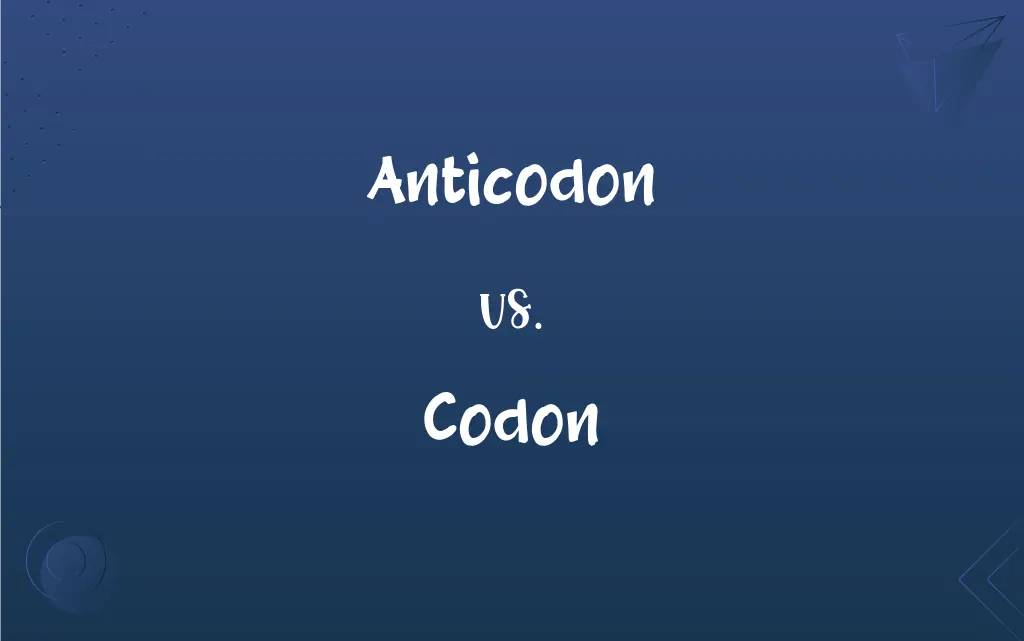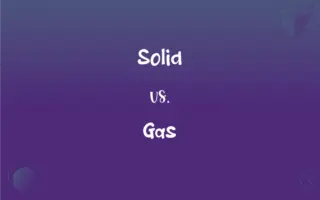Anticodon vs. Codon: What's the Difference?
Edited by Aimie Carlson || By Harlon Moss || Updated on October 27, 2023
Anticodons are sequences on tRNA that pair with mRNA codons, which are triplets coding for amino acids

Key Differences
An anticodon is a sequence of three nucleotides on transfer RNA (tRNA), complementary to a corresponding codon on messenger RNA (mRNA), which is also a sequence of three nucleotides but specifies a particular amino acid.
The anticodon ensures the correct amino acid is incorporated during protein synthesis, while the codon serves as a genetic code for building proteins, each representing a specific amino acid.
In the process of translation, the anticodon of tRNA pairs with its complementary codon on mRNA, ensuring the proper sequence of amino acids in the resultant protein.
Anticodons play a crucial role in the accuracy of protein synthesis, while codons are vital for storing and transmitting genetic information within a cell.
Anticodons are part of the structure of tRNA, which helps in decoding mRNA, while codons are found on mRNA, derived from DNA during transcription.
ADVERTISEMENT
Comparison Chart
Location
On tRNA
On mRNA
Function
Complementary pairing with codon
Encodes specific amino acids
Role in Protein Synthesis
Ensures correct amino acid addition
Specifies amino acid sequence
Sequence
Complementary to codon
Unique for each amino acid
Involvement in Genetic Code
Decoding
Encoding
ADVERTISEMENT
Anticodon and Codon Definitions
Anticodon
Part of tRNA structure for decoding mRNA.
The anticodon loop on tRNA recognizes mRNA codons.
Codon
A three-nucleotide sequence on mRNA.
The codon AUG codes for the amino acid methionine.
Anticodon
A sequence on tRNA complementary to mRNA codon.
The anticodon UAC pairs with the codon AUG.
Codon
Encodes specific amino acids in proteins.
Each codon corresponds to a particular amino acid.
Anticodon
Ensures correct amino acid in protein synthesis.
Each anticodon corresponds to a specific amino acid.
Codon
Fundamental unit in genetic code.
Codons are the building blocks of genetic instructions.
Anticodon
Involved in translating genetic information.
Anticodons play a key role in the translation process.
Codon
Derived from DNA during transcription.
MRNA codons are transcribed from DNA.
Anticodon
Complementary to codons in genetic code.
Anticodons ensure the accuracy of protein synthesis.
Codon
Vital for protein synthesis.
Codons guide the assembly of amino acids into proteins.
Anticodon
A sequence of three adjacent nucleotides in transfer RNA that binds to a corresponding codon in messenger RNA and designates a specific amino acid during protein synthesis.
Codon
A sequence of three adjacent nucleotides constituting the genetic code that determines the insertion of a specific amino acid in a polypeptide chain during protein synthesis or the signal to stop protein synthesis.
Anticodon
(genetics) A sequence of three nucleotides in transfer RNA that binds to the complementary triplet (codon) in messenger RNA to specify an amino acid during protein synthesis.
FAQs
Where are anticodons located?
Anticodons are located on transfer RNA (tRNA) molecules.
What is an anticodon?
An anticodon is a sequence of three nucleotides in a tRNA molecule that is complementary to a codon in mRNA.
Where are codons found?
Codons are found in messenger RNA (mRNA) molecules.
What is a codon?
A codon is a sequence of three nucleotides in mRNA that specifies a particular amino acid or signifies a start or stop signal for protein synthesis.
What role does the ribosome play with codons and anticodons?
The ribosome facilitates the pairing of tRNA anticodons with mRNA codons during translation.
Do stop codons have corresponding anticodons?
Stop codons do not have corresponding tRNA anticodons. Instead, release factors recognize stop codons and terminate translation.
What is the function of an anticodon?
The anticodon pairs with its complementary codon in mRNA, ensuring the correct amino acid is added during protein synthesis.
How many possible codons are there?
There are 64 possible codons, corresponding to 20 amino acids and several start and stop signals.
Can multiple codons code for the same amino acid?
Yes, due to the redundancy of the genetic code, several codons can specify the same amino acid.
What happens if there's a mistake in the codon sequence?
A mistake in the codon sequence can result in the incorporation of the wrong amino acid, potentially affecting protein function.
What is a stop codon?
A stop codon signals the end of translation. There are three stop codons: UAA, UAG, and UGA.
How do codons relate to protein synthesis?
Codons in mRNA dictate the sequence of amino acids in a protein during the process of translation.
How do anticodons recognize codons?
Anticodons form base pairs with their complementary codons in mRNA during translation.
Do anticodons and codons have the same nucleotide sequence?
No, anticodons are complementary to codons. For instance, if a codon sequence is AUG, the corresponding anticodon will be UAC.
Why are anticodons important in translation?
Anticodons ensure that the correct amino acids are incorporated into the growing polypeptide chain based on the mRNA sequence.
Can changes in codons affect the function of proteins?
Yes, changes in codons (mutations) can lead to changes in amino acid sequences, potentially altering protein function or structure.
How does the anticodon-codon interaction ensure the accuracy of protein synthesis?
The specific base-pairing between anticodons and codons ensures the correct sequence of amino acids in a protein, preserving its function and structure.
Are codons always three nucleotides long?
Yes, codons always consist of three nucleotides.
Is there a specific start codon?
Yes, the codon AUG serves as the start codon and also codes for the amino acid methionine.
Can tRNA molecules carry any amino acid?
No, each tRNA molecule is specific to one amino acid, determined by its anticodon.
About Author
Written by
Harlon MossHarlon is a seasoned quality moderator and accomplished content writer for Difference Wiki. An alumnus of the prestigious University of California, he earned his degree in Computer Science. Leveraging his academic background, Harlon brings a meticulous and informed perspective to his work, ensuring content accuracy and excellence.
Edited by
Aimie CarlsonAimie Carlson, holding a master's degree in English literature, is a fervent English language enthusiast. She lends her writing talents to Difference Wiki, a prominent website that specializes in comparisons, offering readers insightful analyses that both captivate and inform.































































